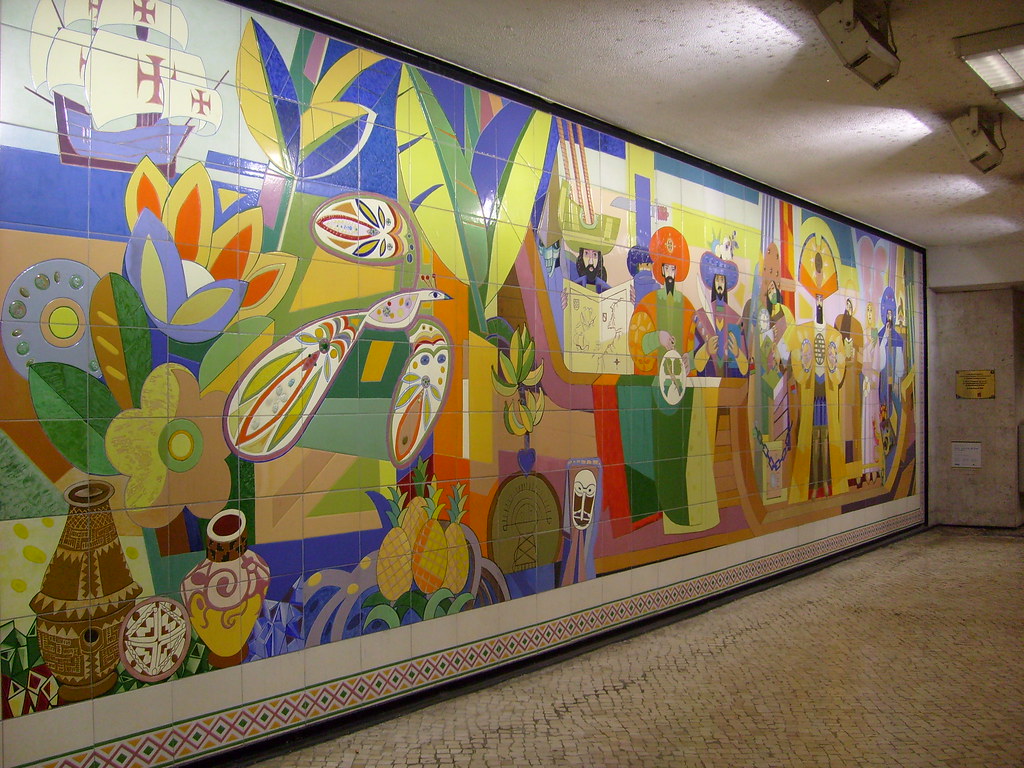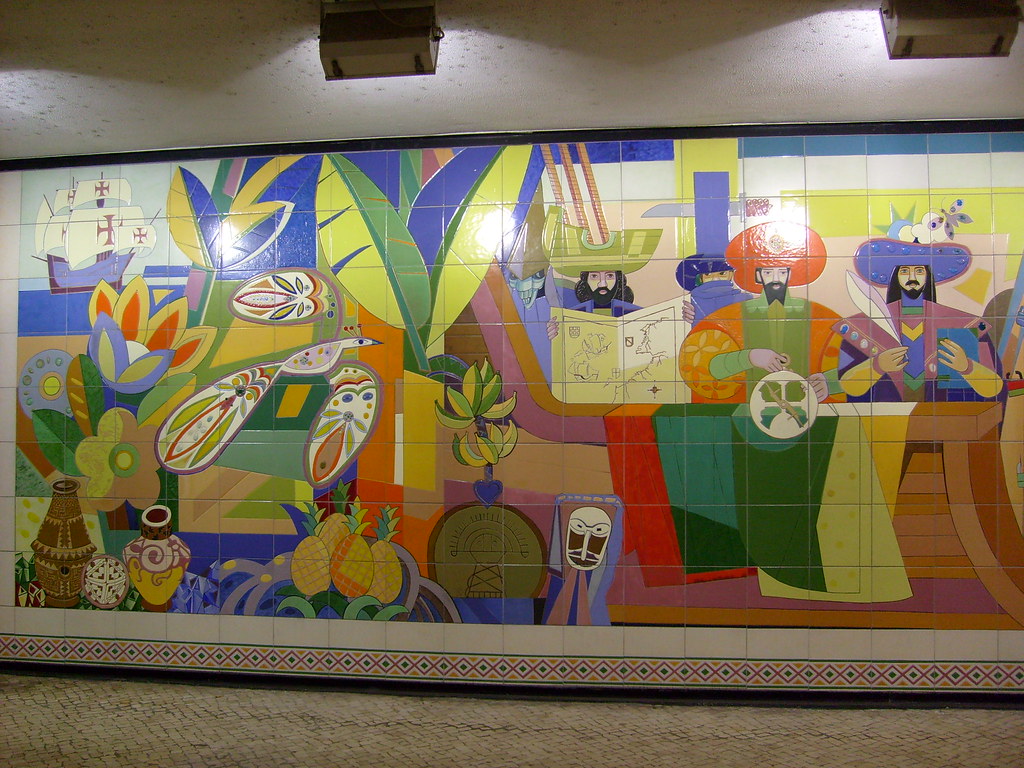
In 1994, is installed in the lobby of the Restauradores metro station a work of the Master Luiz Ventura called "Brazil-Portugal: 500 years - the arrivance", which is the counterpart of the work of Master David de Almeida "The road of Water" and "The ways of Heaven ", Offered to the subway station Conception of Sao Paulo.
The author makes us a description of work:
"The arrivance" is an interpretation of the meeting of two radically different cultures, meeting that initiated the process of what is now the Brazilian nation.
To mark these differences the artist transforms them into characters to occupy the place of the figures recorded by history. Thus, the mercantilist Idealism is the central character, bearing the pictures of private property on one side and the Religion of the other. Completing the cast of 12 characters we have Well, evil, the Greed, the Militarism, the Science, Technology, Culture, the ambiguity and, finally, the Phantom.
The panel is surrounded at the base and sides by a frieze with drawing from the plot of vines, straw, common in many tribes of Brazil.
The ceramic gems on show are of indigenous technology and art - the ocarina of the tribe Tukan, the bowl and pot-Tribe Kadiwéu.
The flora permeates the picture that leads us to a Portuguese ship the whole cloth. Of mangrove roots, fruits and bird (this with elements of indigenous Plumeria) with a graphics (not identified in order to signal the extinction of indigenous peoples) and ceremonial mask Tukan, together with the vessel and its crew.
Presents itself, then the decoding of some signs the second author's own words:
The Idealism mercantilist - central character that marks the story.
The Private Property - in Brazil was an agrarian society differentiated, that is, a society without social classes, not private property. Symbolic elements of ownership, ancient and contemporary, feature the character.
The Science - symbolized by the astrolabe, the presence of mathematicians, geographers, astronomers and pilots who created the Rules of the Astrolabe, instrumental in the advancement of naval expeditions. The astrolabe is supported in tissues with the national colors of Portugal and Brazil.
The Technology - The technological advance is shown by the shipbuilding that has allowed the squad to travel by Pedro Alvares Cabral to Brazil. The nautical knowledge are symbolized by the statement which marks the coasts of Spain, Portugal and Africa. Several ships in the ocean, rumando to Brazil, complete the "framework".
The Culture - Represented by character with pen and book in hand. Hat in the sun, moon, the cloud, the butterfly: symbols of artistic creation.
The Religion - represents a religious including the concepts of Good (Angel) and Evil (devil).
The Good - with angel wings and halo. Flower and heart recall its libertarian fight of the 70s with the slogan "Peace and Love."
The Evil - The devil signals its symbol.
The Greed - symbolized by the left hand supported the lid of the trunk with objects of arrest or punishment used to subject them slaves.
The ambiguity - in the universal literature are often a dubious character or concealed that stimulates our curiosity, and that is represented here by embuçado crossed with a machete in the hat. Is the ambiguity in person?
The Militarism - The launches mark the use of force in defense of "established order".
The Phantom - Character situated at the edge of the vessel with the forest. Represent the threat of the unknown? Represent the fear of the spread of disease nonexistent in this continent? Represent the speaking of slavery. "
From the standpoint of technique used notes, if the paint brush, the rope vitrificável drought in enamel on ceramic, and applications of crystal Murano. The execution was in charge of designing Artistic Pottery, Sao Paulo, Brazil.
In August 1998 the link was inaugurated Restauradores Lower / Chiado, the lobby of South reshuffle of the station Restauradores entered into this venture. The corresponding design is from Architect of Manuel Bridge and the interventions are of plastic and Lake Nadir Afonso Henriques. [*]
The author makes us a description of work:
"The arrivance" is an interpretation of the meeting of two radically different cultures, meeting that initiated the process of what is now the Brazilian nation.
To mark these differences the artist transforms them into characters to occupy the place of the figures recorded by history. Thus, the mercantilist Idealism is the central character, bearing the pictures of private property on one side and the Religion of the other. Completing the cast of 12 characters we have Well, evil, the Greed, the Militarism, the Science, Technology, Culture, the ambiguity and, finally, the Phantom.
The panel is surrounded at the base and sides by a frieze with drawing from the plot of vines, straw, common in many tribes of Brazil.
The ceramic gems on show are of indigenous technology and art - the ocarina of the tribe Tukan, the bowl and pot-Tribe Kadiwéu.
The flora permeates the picture that leads us to a Portuguese ship the whole cloth. Of mangrove roots, fruits and bird (this with elements of indigenous Plumeria) with a graphics (not identified in order to signal the extinction of indigenous peoples) and ceremonial mask Tukan, together with the vessel and its crew.
Presents itself, then the decoding of some signs the second author's own words:
The Idealism mercantilist - central character that marks the story.
The Private Property - in Brazil was an agrarian society differentiated, that is, a society without social classes, not private property. Symbolic elements of ownership, ancient and contemporary, feature the character.
The Science - symbolized by the astrolabe, the presence of mathematicians, geographers, astronomers and pilots who created the Rules of the Astrolabe, instrumental in the advancement of naval expeditions. The astrolabe is supported in tissues with the national colors of Portugal and Brazil.
The Technology - The technological advance is shown by the shipbuilding that has allowed the squad to travel by Pedro Alvares Cabral to Brazil. The nautical knowledge are symbolized by the statement which marks the coasts of Spain, Portugal and Africa. Several ships in the ocean, rumando to Brazil, complete the "framework".
The Culture - Represented by character with pen and book in hand. Hat in the sun, moon, the cloud, the butterfly: symbols of artistic creation.
The Religion - represents a religious including the concepts of Good (Angel) and Evil (devil).
The Good - with angel wings and halo. Flower and heart recall its libertarian fight of the 70s with the slogan "Peace and Love."
The Evil - The devil signals its symbol.
The Greed - symbolized by the left hand supported the lid of the trunk with objects of arrest or punishment used to subject them slaves.
The ambiguity - in the universal literature are often a dubious character or concealed that stimulates our curiosity, and that is represented here by embuçado crossed with a machete in the hat. Is the ambiguity in person?
The Militarism - The launches mark the use of force in defense of "established order".
The Phantom - Character situated at the edge of the vessel with the forest. Represent the threat of the unknown? Represent the fear of the spread of disease nonexistent in this continent? Represent the speaking of slavery. "
From the standpoint of technique used notes, if the paint brush, the rope vitrificável drought in enamel on ceramic, and applications of crystal Murano. The execution was in charge of designing Artistic Pottery, Sao Paulo, Brazil.
In August 1998 the link was inaugurated Restauradores Lower / Chiado, the lobby of South reshuffle of the station Restauradores entered into this venture. The corresponding design is from Architect of Manuel Bridge and the interventions are of plastic and Lake Nadir Afonso Henriques. [*]








5 comments:
A beautiful tile mural. With the explanation I can see the happenings. Very interesting. thanks. MB
This is one the most beautiful tile murals I've ever seen and you've given such a detailed description, really wonderful.
By the way, I mention you on my blog today. :`)
A beautiful & colourful mural. Interesting info to. Thanks for sharing
Beautiful mural and wonderful description. You are a wonderful photographer and writer.
Excellent post. Great mural too, it must be very impressive in the 'real.'
I will come back to re-read more carefully what you've written here.
Post a Comment